Fundraising Technology Trends Study
Recently we surveyed 142 fundraisers about their use of technology and fundraising software. Each of the fundraisers shared with us how successful they’ve been growing contributions. They also described their software management platforms, communication channels, and payment acceptance methods.
By comparing technology use and effectiveness, patterns emerged. Taken together, the patterns point out a specific direction toward fundraising success. We’re excited to share the results with non-profit organizations.
Here are some of the key findings:
- Revenue growth is not assured. 47% of non-profits generated the same or less revenue in 2013 compared to 2012.
- Fundraisers believe in technology, but often lack it. 4 out of 5 fundraisers feel that better technology leads to fundraising success. But only 1 in 3 say they have the tools they need to be effective.
- Leveraging the web matters. Non-profits who accept online donations are 24% more likely to have increased fundraising revenue last year. Tactics such as blogging and sharing video content increase the effectiveness further.
- Diversification is key. Using a greater variety of software, channels, and payment methods correlates strongly with fundraising success.
- There is an optimal technology profile of a successful fundraiser. 83% of the fundraisers who achieved it describe their fundraising as either “effective” or “very effective.”
So what exactly are today’s most successful fundraisers doing that you might not be? Read on to find out.
- The State of Fundraising Today
- Attitudes and Opinions on Fundraising Success
- Fundraising Management Software Tools
- Communication Channel Usage in Fundraising
- Web-Based Communication Channel Usage
- Payment Method Acceptance
- The Profile of a Successful Fundraiser
- Taking It Into the World
- Study Demographics and Data
- Credits
- Co-Sponsor Information
The State of Fundraising Today
Before you can measure the impact of technology, you need to look first at typical fundraising results.
To establish benchmarks, we asked the following questions:
- Compared to 2012, how much money did your organization raise in 2013?
- Compared to 2013, how much money do you expect to raise in 2014? And,
- How would you rate your organization’s effectiveness raising money?
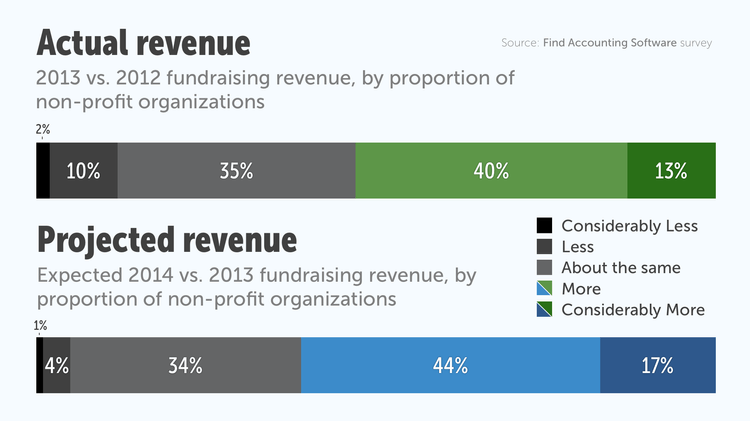
So how successful are non-profits at increasing fundraising revenue? It’s a bit of a mixed bag, actually.
53% of non-profits increased 2013 revenues. And, only 12% of organizations raised less revenue in the same period. It’s encouraging that few fundraisers report moving backwards.
But 35% of the organizations generated about the same amount of revenue in 2013 as the previous year. It’s less encouraging to realize that almost half of fundraisers (47% in total) were not able to grow their 2013 revenue.
The outlook for fundraising growth moving forward is somewhat rosier.
Just 5% of non-profits expect 2014 revenue will drop compared to 2013. 12x as many organizations (61%) expect to grow this year’s revenue.
Still, there is room for improvement. 34% of fundraisers expect to tread water in 2014 and keep revenue about the same.

Year-to-year revenue growth is one measure of fundraising success. But it isn’t the only one.
Imagine a non-profit that increased revenues, but didn’t cover costs. They’d likely take a negative view of their results. We wanted to get a more nuanced picture to account for these situations. So we asked fundraisers to rate their organizations’ general “effectiveness” at raising money.
Fundraisers are a self-critical lot it turns out. Only 45% say their organization is “effective” or “very effective” at raising money. 29% say they are “average.” About a quarter of fundraisers feel their non-profit is either “somewhat ineffective” or “ineffective.”
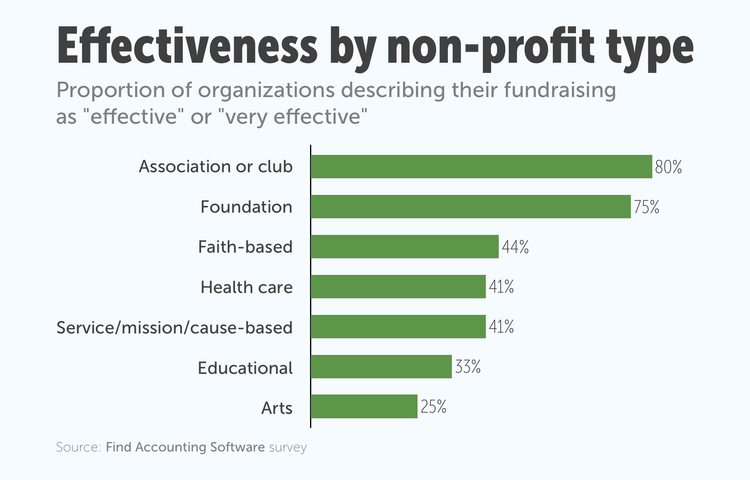
Of course, not all non-profits organizations are the same. The fundraising that a church conducts is different than a foundation’s. Unsurprisingly, different types of non-profits report differing levels of effectiveness raising money.
Associations and foundations have the most positive outlook on their ability to raise funds. Educational and arts-based organizations are at the other end of the spectrum. Fundraisers in these fields are much less likely to view themselves as effective fundraisers.
What accounts for the difference? I asked Amalia Schoone. Amalia is the President of the Southeast Wisconsin chapter of the Association of Fundraising Professionals. Amalia’s opinion was that the biggest factor on fundraising success is unique organizational resources. But she also said, “Organizational types with higher rates of effectiveness tend to be those specifically designed to engage members or raise funds.”

What about organization size? Is bigger better when it comes to promoting fundraising revenue growth? Do larger non-profits have an advantage? Not according to the data.
The percent of small, medium, and large non-profits who said they grew year-to-year revenue was remarkably similar.
Attitudes and Opinions on Fundraising Success
Fundraising is not easy. And a big reason for that is the enormous amount of competition. In the US alone, there are more than 1.4 million non-profit organizations vying for funds. Not only that, but charitable giving has remained at 2% of GDP for the last 4 decades. (Philanthropy.com)
What challenges do fundraisers perceive in this crowded environment? And, do fundraisers trust technology to help them overcome them? We asked the following questions to find out:
- What is your organization’s biggest fundraising challenge?
- Do you agree with this statement? “Better technology leads to more effective fundraising.”
- Do you believe your organization currently has all the technology tools it needs to effectively raise funds?
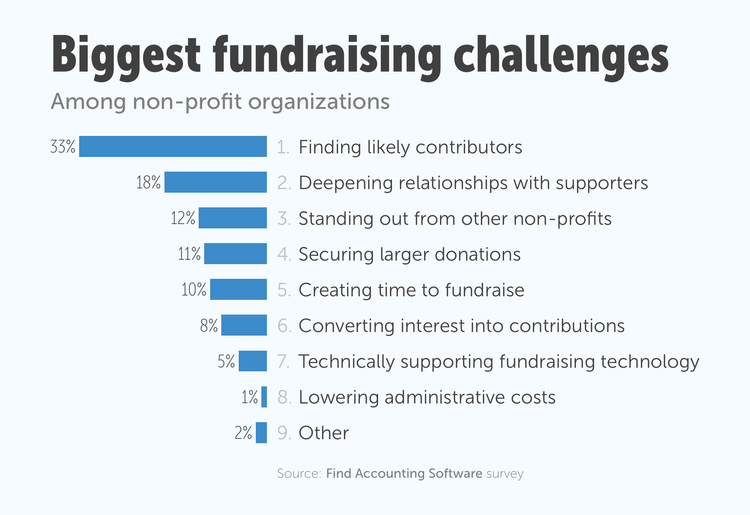
It’s no secret that fundraisers face a wide variety of challenges.
“Finding likely contributors” is the most significant, though. A third of fundraisers described it as their biggest challenge.
Otherwise, opinion was split among a variety of challenges.
One trend that stuck out in the data is worth noting, though. Communication-oriented challenges outranked administrative ones. Just 6% of fundraisers’ biggest challenge was “supporting technology” or “lowering administrative costs.” “Deepening relationships,” “securing larger donations,” and “converting donor interest” all ranked higher.
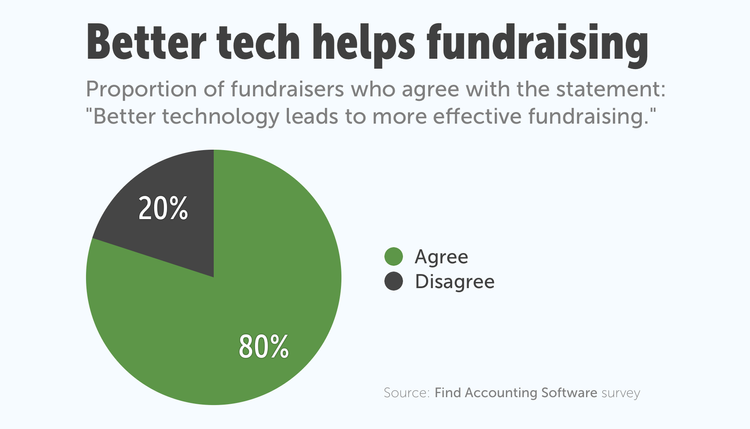
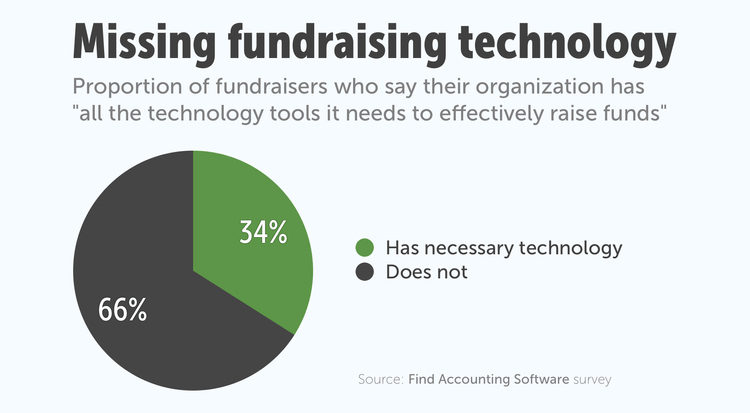
Overall, fundraisers trust technology to help them meet fundraising challenges. But they don’t feel their current tools are adequate.
4 out of 5 fundraisers agreed that, “Better technology leads to more effective fundraising.” But, only 1 in 3 feel their organization has “all the technology tools it needs to effectively raise funds.”
The attitudes were perceptive. The rest of the study data confirmed that well-outfitted, technology-enabled fundraisers did outperform their peers. More on that now.
Fundraising Management Software Tools
Today’s fundraisers have access to an enormous variety of fundraising management software products. We asked fundraisers to share with us which software tools they used.
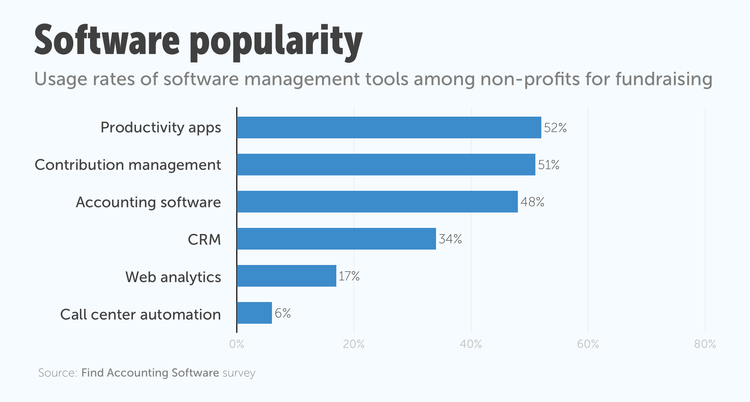
We found fundraisers rely on three main types of software tools above others for managing their efforts. The popularity of each was not surprising.
- Productivity applications (52%). Microsoft Office and Google Docs are popular and flexible software suites. Though they lack specialized non-profit features, they can be used for a variety of fundraising tasks.
- Contributions management software (51%). Donor management suites provide tools for the management, execution, and tracking of fundraising activities.
- Accounting software (48%). Accounting programs are common in offices of both for-profit and non-profit organizations. Non-profits can use accounting software to track fundraising results and even store donor info.
CRM software is also used by many fundraisers (34%). While it isn’t designed exclusively for fundraising activities–like contributions management software–it offers much of the same raw functionality. Many fundraising communication tasks mirror the sales tasks CRM software helps automate and manage.
Web analytics and call center automation software tools don’t cover as wide a scope of activities. In fact, they’re designed to manage and measure single communication channels. Given their specialized nature, it follows that fewer organizations use them.
The big question though is what works?
Here’s a summary of the percent of organizations in each software use-group that grew 2013 revenues:
- CRM software (65% reported revenue growth)
- Contributions management software (62%)
- Accounting software (61%)
- Productivity applications (60%)
- Web analytics (57%)
- Call center automation (29%)
Each software use group saw an above average percent of organizations growing revenue. (The exception was call center automation software users. But that’s likely a quirk based on their unusually small sample size.)
What is significant though is the comparison between software users and non-users. Non-profits who did not use software to manage their fundraising reported especially poor results. Only 1 in 4 said they had grown 2013 revenues. They weren’t optimistic for the future either. Only 1 in 3 expected to grow revenues in 2014.
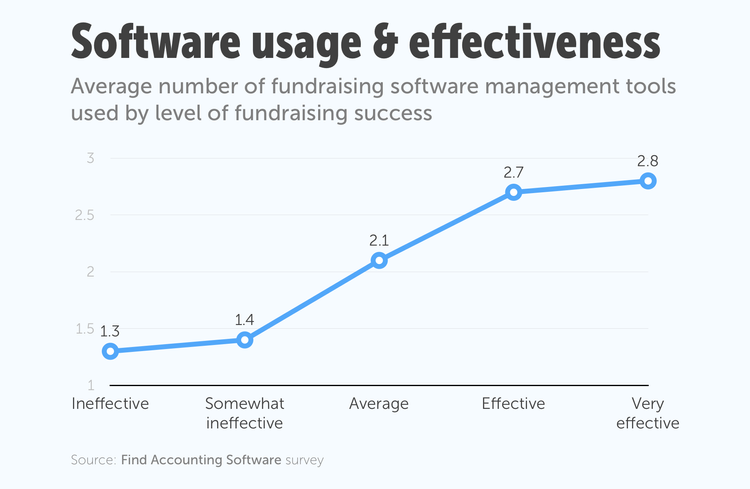
If a lack of software correlates with poor results, is there an advantage to using multiple software programs? Is more better?
The data suggests the answer is yes. “Effective” and “very effective” fundraisers use twice as many software programs as “somewhat ineffective” and “ineffective” fundraisers.
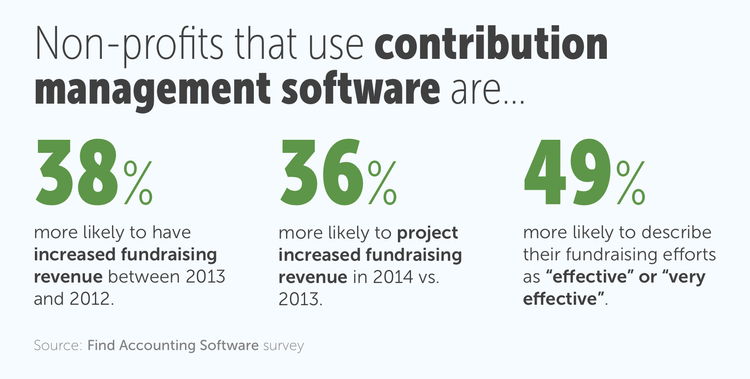
Contributions management software is of particular interest to many fundraisers. It is, after all, the category of software designed especially for improving fundraising results. Further, over half the fundraisers we heard from use it. Does contributions management software deliver?
Based on the data, contributions management solutions have a strong positive impact. Users report better past revenue performance and elevated expectations for future growth. Users of contributions management software also are 49% more likely to view their fundraising efforts as effective.
Communication Channel Usage in Fundraising
Fundraisers have lots of choices when it comes to technology. And, these choices aren’t limited to their software, either. There are many communication channels to choose from as well.
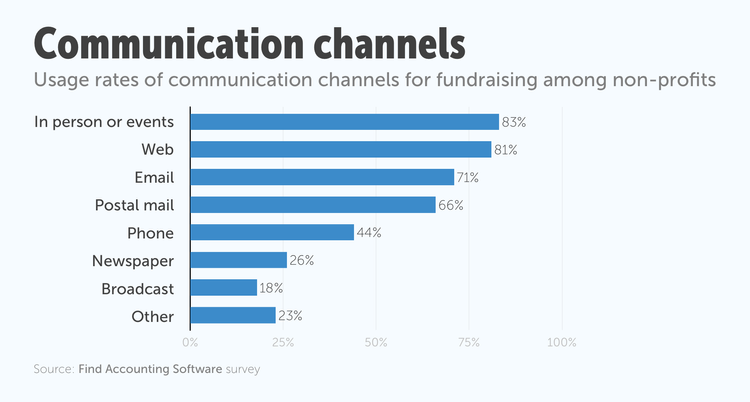
Face-to-face contact is still a big part of raising money. 4 out of 5 fundraisers use in-person appeals and events to drive their fundraising efforts.
But in-person approaches aren’t stopping fundraisers from connecting with donors online. Over 80% of fundraisers also use the web as a main channel. Another 70% raise funds via email.
In fact, the use of so-called “new” media outpaced traditional media. Email was more popular than postal mail (66%). And, the web was more popular than seeking donors via print media like newspapers and periodicals (26%). Even fewer fundraisers used broadcast media such as TV and radio (18%).
While some communication channels were less popular, we found that fundraisers can still effectively use all of them.
Here’s how we know: First, we isolated the user groups for each communication channel. Then we looked at each user group’s expectations for 2014 revenue growth. We saw that each fundraising channel user group had similar expectations. 63.3% of organizations using in-person/events communication expect to grow revenue this year. The number was 67.6% for print media fundraisers. Each of the other channels also fell within this range.
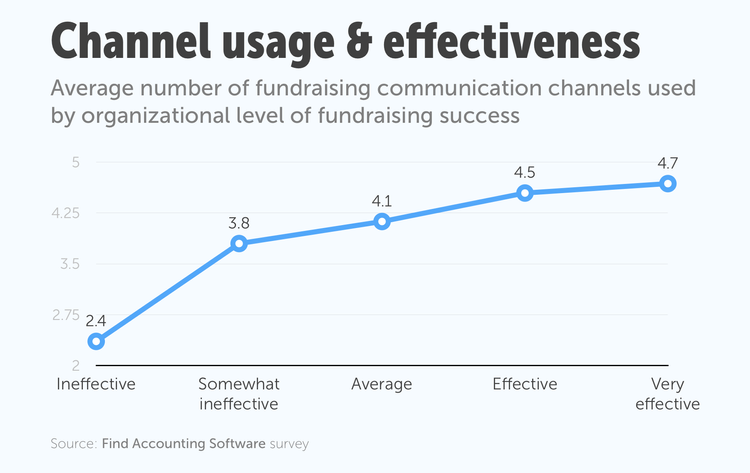
What about multi-channel fundraising? To what degree is success a product of reaching out to donors in different places, by different means?
According to the data, diversifying fundraising channels is a major success factor.
“Ineffective” fundraisers only used 2.4 communication channels on average. “Very effective” fundraisers, though, used an average of 4.7 different channels.
Fundraisers who relied on a single channel saw especially bad results. Just 18% of single channel fundraisers increased their 2013 revenue compared to 2012.
That success/failure rate for fundraising revenue growth inverted itself among highly diversified fundraisers. 82% of fundraisers using 7 or more channels grew their 2013 revenues.
Web-Based Communication Channel Usage
To this point, we’ve reported all web communication as a single channel. But there are many ways fundraisers can communicate with donors online.
A couple questions likely will come to the mind of the inquisitive fundraiser looking to improve their results:
- Which web channels are other non-profits using?
- Which ones are delivering the best results?
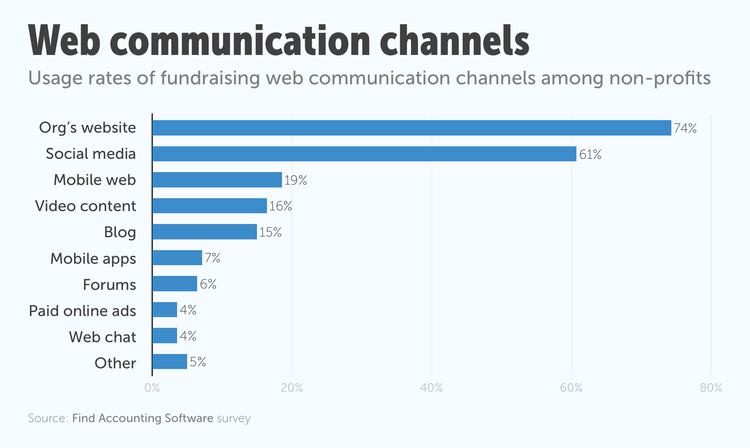
Direct website communication and social media are the most popular web fundraising channels. About 3 out of 4 non-profits report utilizing their own website for fundraising purposes. A significant number of fundraisers are also taking to social media to communicate with donors (61%).
To a lesser degree, non-profits are also experimenting with other web fundraising channels. About 1 in 5 use mobile web. Closer to 1 in 7 fundraising organizations are using video content or blogging. Meanwhile, fewer than 1 in 10 non-profits are trying mobile apps, forums, online ads, and web chat.
Fundraisers are reporting positive results across each of these web communication channels.
Non-profits using websites, social media, mobile web, video content, blogging, forums, mobile apps, and web chat are ALL more likely to have increased year-to-year revenue.
But fundraisers who are blogging and using video content are particularly successful. Bloggers were 34% more likely than non-bloggers to report growth in their organization’s 2013 revenue. Non-profits using video content were 47% more likely to have grown their 2013 revenue.
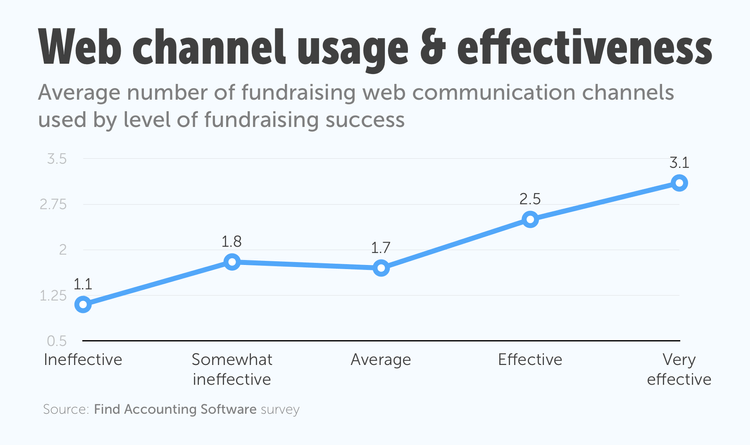
The impact of multi-channel fundraising is no less strong when it comes to web communication.
In fact, “very effective” non-profits used 3x as many web channels as “ineffective” ones, on average.
Non-profits using 5 or more web channels were particularly likely to report success. 71% of these organizations grew their 2013 revenue over 2012 numbers. The number dropped to 59% for non-profits who focused web communication on a single channel.
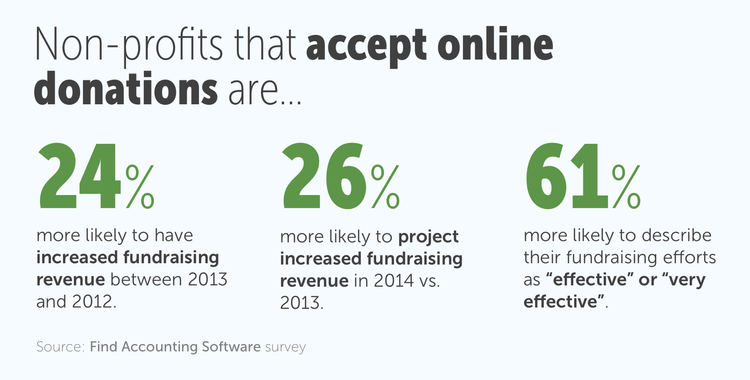
Another powerful success factor for fundraisers is the ability to accept online donations.
Currently, 70% of non-profit organizations have the capacity to accept donations online.
The data shows a clear positive impact based on online donation acceptance. Non-profits who accept funds via the web reported higher rates of past revenue growth. They’re also more inclined to expect revenue growth this year. Further, non-profits who take donations online are 61% more likely to say they are effective at raising money.
Payment Method Acceptance
Technology has changed the way non-profits manage their fundraising and communicate with donors. But it has done more than that. It’s also expanded the ways that contributors can give.
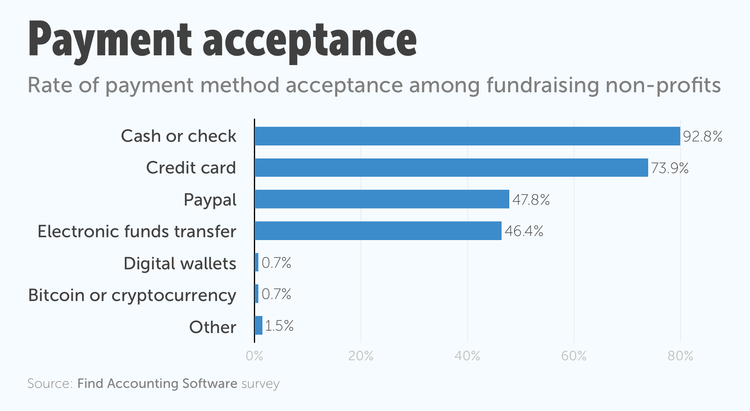
So how are non-profits receiving donations?
Clearly, cash is still king. 93% of fundraising organizations report accepting donations via cash or check.
Credit card (74%) acceptance remains popular as well.
But many non-profits are also using newer formats like Paypal (48%) and EFT (46%).
Cutting edge technologies like crypto-currencies (1%) and digital wallets (1%) are beginning to appear.
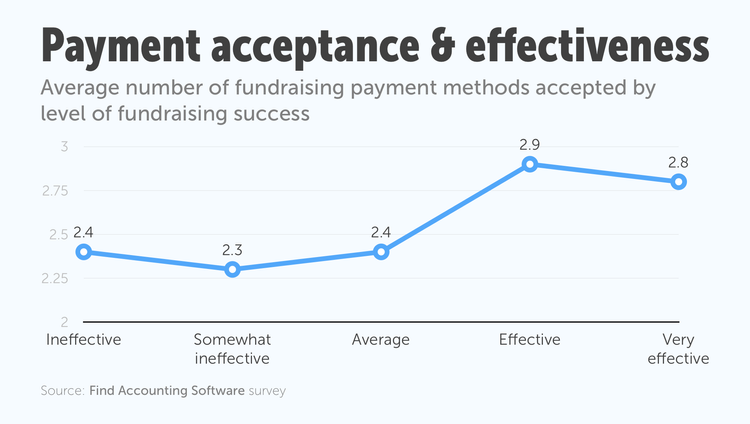
Previously, we saw that using more management tools and communication channels leads to positive results for fundraisers. Expanding the number of payment methods also helped fundraisers improve their results.
56% of organizations who accepted funds via multiple methods grew their 2013 revenues. Only 35% of the organizations who relied on a single payment method were able to say the same thing.
The Profile of a Successful Fundraiser
So is there a profile of a successful fundraiser? Yes, actually, there is.
Technology diversification is a powerful accelerator of fundraising success it turns out. The most effective fundraisers use more software, communication channels, and payment options than their less effective peers.
To be even more specific, “very effective” fundraisers use on average:
- 3+ software management tools,
- 5+ communication channels,
- 3+ web-based tactics, and
- 3+ payment acceptance methods.
Other key success factors included:
- Online donation acceptance,
- Contributions management software usage.
- Video content sharing, and
- Blogging.
Less than 10% of the non-profit we heard from met each criterion. But the organizations who achieved the best practice standards experienced exceptional results:
- 67% said their 2013 revenues were “considerably more” than 2012.
- 83% expect to grow 2014 revenues.
- 83% describe their organization as “effective” or “very effective” at raising money.
Taking It Into the World
The promise of technology to improve how things get done is not new. But the instantaneous, mass communication allowed by web technology has provided some specific new opportunities for non-profits.
Today, non-profits are using technology to draw on the lessons of their peers. Fundraisers are sharing their results–not only in web studies like this one, but in many other online communities. As they do so, a clearer picture is emerging about the critical role technology can play in successful fundraising.
After that, Prometheus taught them, little by little, a thousand things. He showed them how to build houses of wood and stone, and how to tame sheep and cattle and make them useful, and how to plow and sow and reap, and how to protect themselves from the storms of winter and the beasts of the woods. Then he showed them how to dig in the earth for copper and iron, and how to melt the ore, and how to hammer it into shape and fashion from it the tools and weapons which they needed in peace and war; and when he saw how happy the world was becoming he cried out: “A new Golden Age shall come, brighter and better by far than the old!”
Study Demographics and Data
All survey takers responded “yes” to the following question: “Do you work or volunteer for a non-profit organization that actively fundraises?”
Survey invitations were sent to US and Canadian based fundraisers.
Survey takers selected from the following classifications to describe their organization: arts-based, association, educational, faith-based, foundation, healthcare, or service, mission, or cause-based.
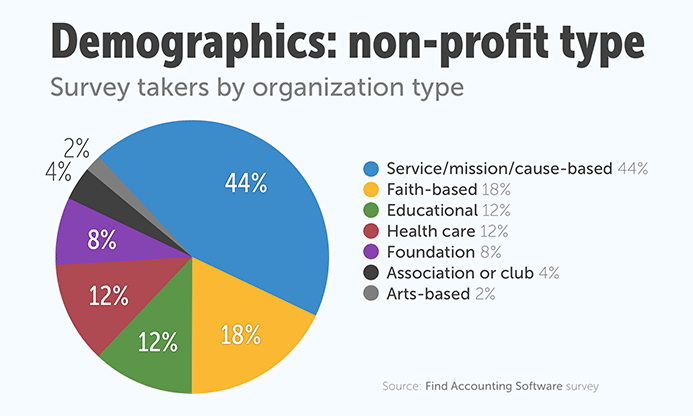

Credits
We’d like to extend our appreciation to each of the 142 fundraisers who generously share their time and experiences in order to provide their colleagues with information on fundraising best practices.
Survey takers selected a charity of their choice to receive a donation pledge. Contributions have been made on their behalf to the following organizations:
- Big Cat Habitat and Gulf Coast Sanctuary
- Tech Soup
- International Rivers
- Trips for Kids
- Mend Poverty
- 501 commons
- Encore.org
We’d also like to thank Lori Jacobwith from Ignited Fundraising for her insightful commentary on the study results.
Our special thanks also to Cougar Mountain, Araize, and the Association of Fundraising Professionals for co-sponsoring the “2014 Fundraising Technology Trends Study.”
Co-Sponsor Information
The Association of Fundraising Professionals (AFP) is the largest professional organization in the world. It’s mission is to “advance philanthropy by enabling people and organizations to practice ethical effective fundraising.” The Southeastern Wisconsin chapter is one of 230 active certified chapters.
Cougar Mountain is a developer of accounting software for non-profit organizations and small businesses. Cougar Mountain has been making software for non-profits for over 30 years.
Araize is a developer of accounting software specifically for non-profit organizations. The Araize FastFund NonProfit Software system offers accounting, fundraising, and payroll functionality.
